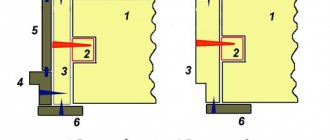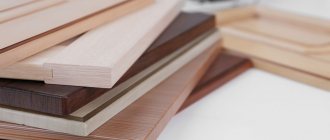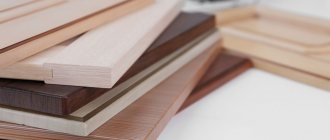When choosing an interior door, any person tries to find a reliable design that will please the eye for a long time.
Unfortunately, such products gradually lose their presentable appearance: time is equally merciless to expensive and budget doors. However, even peeling paint does not make the product less durable and reliable.
One of the advantages of wooden doors is the possibility of restoration. It is enough to remove the old coating and repaint the canvas to make the door look fresh and impressive.
Let's try to figure out how to paint a door made of solid pine and other types of wood.
How to repaint an interior door with your own hands?
An important part of the renovation is the replacement of interior doors. However, if the doors have not lost their properties and are capable of serving for more than one year, then changing them will be pointless. In this case, to repair them, it will be enough to update the color by painting the doors. This procedure is not complicated, and you can do it yourself. We are telling you step-by-step instructions on what you need to know in order to repaint an interior door with your own hands without any problems.
Preparing to paint an interior door
First of all, you need to clean the surface, handles and glass inserts from dust. You should also remove the old layer of paint. It is not necessary to remove the door from its hinges; contact with a minimum number of surfaces allows you to obtain the best quality of painting.
Next, you need to remove the handle and lock, filling the resulting void with rags or cotton wool. To make it convenient to open and close doors, stretch a wire instead of a lock. It is better to cover elements that will not be painted with polyethylene or glue newspaper with toothpaste.
If you find it inconvenient to paint a door that is in a vertical position, you can remove it and place it on the table.
Choosing paint to repaint an interior door
The main issue when performing these works is the selection of paint, which is carried out based on the door material and the nature of the old coating.
Repaint the interior door, tools
The result of the work depends not only on the choice of paint, but also on the tools used, the choice of which depends on the door material, the paint used, as well as the desired result.
So, when painting an interior door with enamel or varnish, you must use a brush. If it is important to preserve the natural structure of the wood, focusing on the patterns, then the best option would be a rubber spatula or sponge. The roller is used when processing large areas.
The spray gun has found its greatest use in painting metal doors.
Source
Technology of painting plastic with a brush
Painting plastic with a brush requires good skill. In this way, it is difficult to make an even coating, and over a large area, unevenness will be very noticeable.
On a note! The brush creates a relatively thick layer of paint and will take longer to dry.
The paint is applied to the plastic in wide, even stripes. Each stroke is first made with a gentle movement (the paint is applied in a relatively thick layer). Then the bristles are pressed more firmly to blend the coating and make the layer thinner. The third movement of the brush should again be light - it evens out the applied material. As a rule, with this application technology, one coat of paint is sufficient.
Basic rules for coloring:
- The brush should not be completely immersed in the coloring composition; it is better to dip only the tip.
- The paint should be applied in as thin a layer as possible, rubbing it thoroughly with tightly pressed bristles.
- To ensure an even coating, the brush must be constantly held at the same angle to the surface to be painted.
Types of paints for interior doors
You can paint wooden doors with varnish to preserve the texture
Paints and varnishes decorate the door leaf and protect it from high humidity and rotting. The service life of the frame and sash increases, the door gets a new beautiful look. If the interior block is in good technical condition, painting the door leaf yourself can be easily done using various wood compounds.
Before work, prepare the surface, putty cracks and chips, then clean it with sandpaper. The primer serves to bind the area to be painted with the paint layer.
Enamels form an outer layer that gives the surface:
Varnishes favorably highlight the wood texture or form a transparent layer on the surface for additional shine.
Water-based gloss paint
The main types that are used for interior openings:
When choosing, take into account the material of the canvas, the presence of old coatings, and the color of the existing paint. Sometimes you need to apply the composition several times to cover and recolor a rich color, especially if you use light colors. Paint and varnish materials are applied 2–3 times, with each layer allowed to dry. Sometimes it needs to be sanded further before applying the next one.
Water-based
This variety refers to water-dispersion paint compositions. It is an emulsion suspension consisting of small polymer particles, water and coloring pigments. Emulsion grains act as the basis of the mixture, but are in an undissolved state.
Emulsions used for production:
Latex paint is resistant to detergents
The properties and qualities of water-emulsion groups depend on the components in the composition. This paint for wooden doors applies smoothly to various surfaces, except for those doors that have a glossy coating applied previously. It is good to use for printing stencils when decoratively repainting canvases.
Qualities of water-based paints:
Water-dispersed materials dry quickly, do not have a strong odor, and you can paint interior doors made of wood, plastic, MDF, plywood, and chipboard. Aqueous polymer emulsions are demanding for transportation and storage.
Moisture resistant
Acrylic paint suitable for interior and exterior use
To repaint doors in the house, colorful materials are used that form a protective film against moisture on the surface. These water-based compositions are used for linens in bathrooms, saunas, and kitchens. The resulting coating is vapor permeable. A matte, even layer hides small defects.
how to paint a brick wall on the street
Polyacrylates (butyl, ethyl and methyl acrylates), resins and copolymers are added to the paint composition to obtain a durable film. Antiseptic modifiers prevent acrylic paint from changing color in high humidity conditions. The white base is colored using dyes for the water-dispersion group.
Properties of acrylic moisture-resistant paint:
Acrylic compounds are diluted with water, but after the film hardens they become moisture resistant. The surface is also difficult to abrade. Door paint is quick-drying and almost odorless. Such surfaces do not fade from ultraviolet rays. The disadvantages include considerable cost compared to ordinary water-based paint.
Before use, acrylic compounds are stirred well and the base is prepared. Fresh wood is impregnated with soil to secure the surface. The first layer is applied with diluted paint, the second is applied without dilution.
Glazing
Glaze paint is used to cover doors that have not previously been coated with any compounds.
The compositions are often used to paint a wooden door that has not previously been coated with paints and varnishes. The mixture includes modified and alkyd resins and oils. Glazing preserves the original appearance of the fiber pattern for a long time and increases the service life of the product. They use colorful materials to impart a natural shine, darken the natural color and reduce the surface texture.
Glazing compounds have the following effect:
Paints do not react to temperature fluctuations or high humidity. For balcony doors, such quality as frost resistance is important. Glaze is transparent, the background can be seen through it, so before use, check the result in a small area. Drying time is from 12 to 24 hours depending on temperature and humidity.
They take products for interior work to paint interior doors. The paints contain harmless components without a strong odor. External products contain synthetic substances, so they are not used indoors.
Glazing differs in the way it is painted, resulting in a rich surface color with smooth transitions. They use a different palette of dyes and apply several layers. Before applying the second and other layers, wait until the previous one has completely dried.
The use of varnish with resins protects wooden doors from moisture
The compositions are produced on the basis of resins; they can be synthetic or natural. Mastics are diluted with solvents, for example, acetone, ethanol, hydrocarbons, essential oils, water. Semi-liquid compositions, when dry, form a transparent film that resists abrasion, moisture, and ultraviolet radiation.
Varnishes on the surface of the canvas harden with the evaporation of a soluble substance or during an oxidative polymerization reaction.
Depending on the method of film formation, they are divided into types:
There are solvent-free varnishes on sale; they are viscous due to oligomers, which harden when catalysts or hardeners are added.
Glossy, matte and colored compositions are used. The texture of the wood or the background of the painted canvas is visible under the varnish, so a door that has no defects on the surface is varnished.
Varnish treatment is accompanied by a pungent odor that lingers in the room for quite a long time.
Modern colored varnishes preserve the original structure of the wood and give it an original shade. Colored compounds are not used for painted surfaces, since the original color will unnaturally change. There are many colors of varnishes, some are pastel, others have a sharp and contrasting shade. Such products are more suitable for natural wood, but they can also be used to paint doors made of chipboard, MDF, and planks.
How to paint plastic from a spray can
The technology for coloring plastics in this case is no different from processing other materials:
- The surface to be painted must be covered around the perimeter with construction tape, and adjacent areas must be protected with paper or oilcloth.
- The can should be shaken well (according to the instructions on the label - from 30 seconds to 3 minutes).
- The paint is sprayed onto the prepared surface from a distance of 20–30 cm.
- Apply the composition with smooth, even movements in one thin layer. Keep the can upright.
- Aerosol paint goes on thinner, so you need to apply two to three layers.
- Each coat must dry before the next is applied (spray paint usually takes 15-20 minutes to dry).
- Immediately after applying the last layer, the construction tape must be removed from the plastic.
Advice! If you need to paint large surfaces, it is worth purchasing a special tip for the spray can. It will help adjust the amount of spray composition and distribute it more evenly.
When the enamel is completely dry, it can be coated on top with acrylic varnish (glossy or matte). This technique is suitable for any method of applying paint. The varnish will protect the coating from damage and extend its service life, as well as additionally level the surface. It is applied in the same way as paint and then dried.
Thus, it is quite possible to paint the plastic with high quality with your own hands. You just need to be careful about the choice of paint and carefully prepare the surface.
Rules for choosing paint
Acrylic paint is odorless and dries quickly
The choice depends on the desired result and painting conditions. Interior doors are treated within the living space, so an odorless finishing product is used so as not to cause allergies or health problems.
There are several types of paints on the construction market:
Oily ones contain oils that do not give off a strong odor. Paints are pigments based on drying oil, which acts as a solvent. Oil paint compositions can be colored or colorless. For new wooden doors, the second type is used, and previously finished ones are repainted with tinted compounds.
Water-dispersed products use water as a solvent, so they have almost no odor. Harmless products are used in children's rooms and bedrooms; during the application process they do not harm human skin upon contact.
Latex enamels are not toxic products; they do not have an unpleasant odor. The paint dries quickly, a film appears after 20 minutes, and full hardening occurs after 1 hour of waiting. The binder is styrene butadiene (synthetic resin).
Acrylic products do not smell because there are no toxins in the mixture. Acrylic-based paints are safe for people during the painting process and after drying during use. Alkyd compounds are not all odorless, but there are appropriate options. There are glossy, matte, semi-matte enamels, the use of which is recommended in rooms where people with allergies live.
Regarding the painting of the pillars near the door windows.
The paint (enamel?) on the door pillars to the right of the glass (for the driver's door) has begun to peel off a little. Initially it is matte and there seems to be no soil behind it and it’s just metal or I don’t understand something.
In general, how is this put in order? And approximately how much does it cost?
Painting 4000 rub. Another 2 Jan found out that the new part is 1200)))))
depending on what kind of car the domestic ones have - they have matte black paint applied over the main color
if the part was changed by thrifty people, then they could not paint the racks at all - leave the black transport primer
on foreign cars, the pillars are usually sealed with film and there should be base paint under the film
In general we are talking about the BMW E39. There are no photos to show right now. In those places where it fell off, metal is visible. In general, what needs to be done? Should I drive up to the service center and have a look? And if there is some kind of film there, how is it restored? on the e 39 this is generally a separate part; the decorative trim is option two 1 can be replaced with a new one 2 can be painted matte black without even removing it from the car, only when painting it’s difficult to get into the degree of matting, so it’s better to paint both adjacent trims of the front and rear doors so that the mat doesn’t differ
There are no photos to show right now. In those places where it fell off, metal is visible. In general, what needs to be done? Should I drive up to the service center and have a look? And if there is some kind of film there, how is it restored? on the e 39 this is generally a separate part; the decorative trim is option two 1 can be replaced with a new one 2 can be painted matte black without even removing it from the car, only when painting it’s difficult to get into the degree of matting, so it’s better to paint both adjacent trims of the front and rear doors so that the mat doesn’t differ
Apparently this part is not sold separately. It just comes out to paint.
maybe it’s in a different group since the diagram shows the door without it, the group should be like moldings and decorative trims
Thank you) The price is reasonable. I looked at the existential 1200 rubles. It turns out it's easier to buy than to try to paint.
Required tools and materials
Container and roller for painting doors
To clean the surface of the door frame and leaf, use a hair dryer, a grinding machine, or manually remove the layer of old paint using emery cloths. The surface is painted using a roller, brush or spray. For primer and paint you need separate brushes or roller handle attachments. You can wash used ones with solvent, but it is better to take new ones.
The roller is used on flat surfaces of the door and on long surfaces of the door opening. Hard-to-reach places are painted with brushes. The sprayer can be used if you have experience working with it. To use it, the surrounding area is covered with old newspapers or polyethylene.
how to change the door handle on a Niva Chevrolet rear door
To lay the canvas in working position, use an old table or special trestles - two stands made of wood or reinforcement.
You will need wood putty; it is usually ready for use and packaged in small containers of 200–250 grams. Take concentrated soil and dilute it according to the instructions on the package. Paint is purchased in accordance with its intended purpose.
Sandpaper is taken No. 60 for large irregularities and No. 120 - 240 for cleaning the putty surface.
To paint or not to paint?
First of all, you need to understand the question: is it possible to paint plastic at all? It is possible, but not everyone. Plastic (plastic) is a collective name, and different materials are hidden under it.
Important! The type of plastic cannot be determined by eye. To find out what kind of plastic an item is made of, you need to find markings on it (two or three capital letters in Latin).
Here are the most common types of plastics and how they relate to painting:
- polystyrene (PS), polycarbonate (PC), polyethylene (PE), polypropylene (PP) – not painted;
- ABS plastic (ABS) and PVC (PVC) - can be painted, but require prior priming.
Types of plastic, marking, scope of application
A separate story with automotive plastics. As a rule, polymers are used here that lend themselves well to painting. But some of them require priming, while others do not. To determine whether a particular part needs to be primed, you can use the following tests:
- Place the entire part or a small piece of it in a container of water. Plastic that sinks can be painted without a primer. And material floating on the surface must be primed.
- Take a small piece of plastic, clean it of old paint and dirt and set it on fire. If the material burns with a clean and even flame, it needs to be primed. And if soot and black smoke are released during combustion, no primer is needed.
Preparatory work
In order for the door to dry faster, before painting it needs to be removed from its hinges and taken outside
A new wooden door is treated with antiseptic compounds and primed. On a previously painted sash, remove the paint if it has peeled off and does not adhere well. The smooth and solid coating is not touched, only sanded with sandpaper and painted in another chosen color. Natural wood is sanded to an ideal surface.
To make it convenient to work, perform the following steps:
It is best to remove the old layer with a hair dryer. You need help with a spatula and sandpaper. After heating, use a spatula to pry off the paint film and remove it. The remaining particles are sanded off. You need to work carefully so as not to damage the door area.
You can use paint remover. The solution penetrates deep into the film and makes it soft, after which it can be easily removed with a spatula. The chemical method works faster, but the product is toxic; you need to use a respirator. With the use of the product, the risk of damaging the area is reduced; the solution is inexpensive.
Putty completes the preparatory stage. The canvas is leveled over the entire area or only cracks are sealed. After the putty has dried, the layer is sanded to a perfect surface.
Pasting or painting Prior door pillars black
Full size Covers for racks
Today I ordered 2 sets at once on this site, after all, it is a film and is not afraid of UV rays (I think so)
(1) Please note, factory and analogue are all films, they differ in texture and adhesive base, the Lada Priora car has already been discontinued, and these linings are available only from Togliatti, on our website there is a description of the product and a corresponding video clip
(2) Do not forget that even the highest quality, expensive vinyl films are designed only for a year of operation, since the environment still has an impact on any material
The money was returned without any problems immediately! Thanks to them for this!
And my solution is painting! For that it is better than any films and will last for at least 5 years)
Features of painting interior doors with your own hands
Old varnish can be removed with a sander
When using a brush, paint in one direction to hide lint marks as much as possible. This method is almost never used due to the sloppy final result. A roller is used more often because it rolls out the paint evenly and leaves no marks. For paints based on acetone, white spirit and solvent, you cannot use a foam nozzle, as the surface will become unusable after several rollings.
There is an option to use a spray gun if the house has several doors to be painted. It is not profitable to rent expensive equipment for one unit.
If the canvas is covered with veneer, it is better not to destroy its integrity during preparation. For cleaning, use a soft rag or brush, and hard-to-reach areas are treated with fine sandpaper. Dust is removed with a brush.
Before painting, clean the floor in the room with a vacuum cleaner or carefully sweep it with a broom, then wipe it with a wet cloth so that dust particles do not settle on the painted surface.
Source
Painting interior doors
Before you paint interior doors, you need to understand the types of structures. There are different options: swing, sliding, folding. However, most of our apartments have swing doors. They provide privacy and play a prominent decorative role in the interior.
Classics of the genre - wooden structures. They are still often found in the entrance area, separating bathrooms and other rooms of the apartment. More budget designs are made from chipboard and MDF.
Now let’s move on to how to paint a wooden door, as well as substitute products, but first, let’s talk about choosing paint for the doors.
What paint to paint interior doors
First of all, you need to decide which composition to choose: solvent-based or water-based?
Solvent based product
These compositions spread evenly on the surface. The hardened layer is resistant to abrasion and periodic cleaning with a wet cloth. However, the process of applying the material with a solvent and the drying time of the paint layer is accompanied by a pungent odor, and to clean brushes and rollers you will need a solvent, for example, white spirit.
Water based
Water-based paints for interior doors are quick-drying and odorless. They are easy to apply, and working tools can be washed off with plain water. However, products painted with water-based compounds do not tolerate active wet cleaning.
Iron parts (hinges, handles) are usually left untouched when repainting.
How to make black door pillars on Lada cars
More affordable configurations of Lada cars (Largus, Priora, Granta or Kalina) are distinguished by door pillars that are painted in body color. On more expensive versions they are black, which makes the car look more modern. Let's look at the process of such tuning in more detail.
Covering door pillars with black film
On configurations, the pillar between the side windows is covered with 3M film. To achieve a similar effect, you can use black Oracal 641 film. Before starting work, remove part of the glass seal, loosen the screw securing the triangular trim and remove the velvet cover.
After which the surface is degreased and covered with film. It is better to bend the edges of the film into the inside of the door. The process is shown in the video:
If you don’t want to bother cutting out the film according to your template, you can buy a ready-made accessory. You can find them by name. “External pillar covers” or “Repair kit for door pillars”. This is a thick self-adhesive film with a rough surface that looks like plastic on the body.
How to paint door pillars black
We degrease the surface, and then cover the body with newspapers using masking tape. Apply black enamel (spray can) in several layers, with an interval of 10-15 minutes. Don't overdo it so the paint doesn't bleed. Then apply varnish in 1-2 layers. The main disadvantage of such a modification is that it will not be possible to return the body to its original state.
Black door pillars will look especially interesting on tinted cars with light enamel colors. By the way, on new Lada models (VESTA and XRAY) the door pillars are painted black for all trim levels.
Black door pillars on the Lada Largus station wagon:
Black door pillars on the Lada Granta sedan:
Black door pillars on the Lada Kalina 2 hatchback:
Black door pillars on the Lada Priora sedan:
Black door pillars on a Niva 4x4 SUV:
Let us remind you that the seals can be modified, which will eliminate glass rattling. You can cover the inside of a car with vinyl film.
Which color to choose
Of course, it depends on your preferences and interior requirements. The most popular options, while being universal, are white and wood-look colors. White is relevant in minimalist, Scandinavian, and classic styles. The same goes for the color of the wood, but the latter will also fit beautifully into the loft style. You can choose two different shades: paint the door from the inside of the room with one to match the color of the walls, for example, and decorate the side that goes into the corridor with a different color.
Cleaning tools from traces of paint
After working with a water-soluble composition, the roller or brush should be immersed in warm water for 2 hours. Then wash under running water and dry. Store tools in a dry place. It is best to hang them down with the bristles. Immerse the brushes with any remaining solvent-based material in a container of white spirit. Moreover, it should reach the base of the bristles. After 2 hours, rinse the instrument and dry with a clean cloth.
It is not advisable to use brushes used to apply a solvent-based composition for work with a water-based composition, and vice versa, no matter how well they are cleaned.
When taking breaks from painting tools, remove excess paint and wrap it in cling film or a plastic bag. The edges can be sealed with masking tape to prevent air from entering, and the devices can be placed in a cool place. So it is permissible to leave the instrument for two days, but no more.
balcony coefficient when calculating the area of an apartment
Source
The nuances of coloring plastic
- Plastic is famous for its insulating qualities, and, as a result, mediocre adhesion. In this regard, not every paint will be able to adhere firmly to the polymer surface;
- Hard types of plastic are easier to paint. Paint may peel off soft surfaces that constantly bend during use. For painting soft products, it is best to use elastic enamel;
- If we are talking about a hard type of plastic, such as that from which containers are made, then universal acrylic enamel is ideal for painting;
- Painting is not carried out in the case of such types of plastic as polyethylene, polystyrene and polypropylene.
Painting wooden doors
Also, this method is not labor-intensive and requires minimal costs! You can paint your interior doors in absolutely any color! Here we will discuss in detail how to do this. But painting requires removing the doors with hinges.
What kind of paint do we use:
What we paint and the technique for painting a door:
A door with embossed overlays looks much more original and interesting than a regular flat one. Making such changes is quite simple and does not take much time. In terms of money, the cost will be only a little more than just painting, and much cheaper than buying a new door.
Necessary materials:
Step-by-step instruction:
Step 1: Paint the door. First you need to repaint the old wooden door in the chosen color, in this case white. Leave to dry.
Step 2: Outlining the location of the planks
On top of the dried paint you need to mark the fastening of the overhead wooden planks. To do this, draw lines with a pencil (without pressing it too hard) and a ruler, to get perpendicular lines, use a construction corner.
In this case, the drawing consists of two rectangles located one above the other.
Step 3: Cut out the strips
Now you need to cut the strips of the appropriate size (measure the length of the outlined lines). If you don't have the necessary tools at home, this can be done directly at a hardware store for a small additional fee. If you do it yourself, you will need not only a saw, but also a miter box to cut the ends of the planks at an angle of 45 degrees.
Step 4: Attach the planks
Place all the planks on the marked lines. Make sure they are all the right length and meet evenly at the corners.
Note: you can glue already painted planks, or glue and then paint; You can also not paint the door at first (skip step 1), but do it together with the glued strips.
Step 5: Install the door
After the glue has dried, you need to carefully peel the tape off the door; it is better to use masking tape that does not leave marks.
Now all that remains is to put the remodeled door in place and attach the handle. And everything is ready!
Painting door pillars black matt
In general, a long time ago I saw an entry on the drive about covering the door pillars with film. I really liked how it looked with the tint and decided to do the same for myself. I bought the film, glued it on, at first everything was ok, but then the film began to curl up and tear in places near the seals. I decided to do everything again and after a while the same problems appeared. I tore off the film and drove like that for a while. Then I decided not to create problems for myself with these films and decided to paint the racks matte. I bought paint and went to my friend Fanat2012 so he could paint them for me. For which I thank him very much) I liked the result, everything is great and now I won’t suffer with these films)
Preparation for the process
First of all, arm yourself with the necessary materials and tools so that you have everything at hand during the work process. You will need:
The door structure consists not only of the canvas, and most often it completely needs painting, otherwise the door will be very different in color from the lintel and jambs. Painting work can be carried out in two ways: in a horizontal or vertical position.
Try to dismantle all the fittings on the door
It will be more convenient to work with the canvas removed, but in some cases the second option is quite applicable. Don't forget to remove all fittings. If the hinges and handles are not removable, you can wrap them in paper and secure them with tape, or even better, wrap them in foil and ensure a tight fit to the parts. Seal the lock mechanisms with tape in a fixed position.
Can the door surface be repainted?
Tip
Renewing the finishing coating returns the door's attractiveness. This is a worthy alternative to completely replacing the canvas.
But sometimes restoration of the external part may be impractical due to significant damage:
- The presence of rot or mold on the material. If destructive processes have affected only the front covering, the sash is repainted, having previously cleaned the problem areas. If rotting is observed throughout the entire thickness of the material, updating the outer layer does not make sense.
- The presence of significant damage: deep chips, unevenness, violation of the geometry of the sash, severe delamination of the canvas, dilapidation of the material. To restore the door, ordinary painting will not be enough: defects are eliminated by deep sanding followed by the use of leveling mixtures or the product is replaced with a new one.











